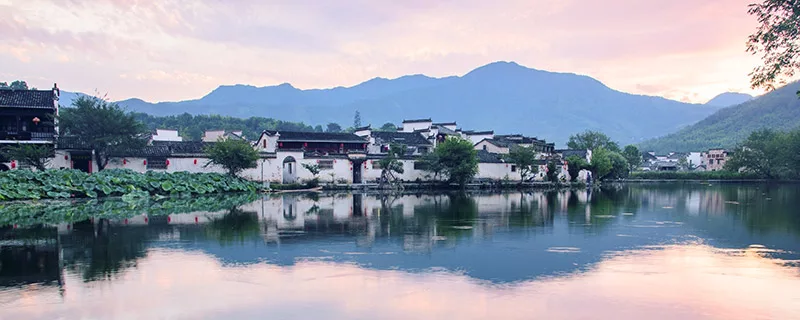After arriving in Huangshan City by high-speed train, it is recommended to stay at the foot of Mount Huangshan for at least one night to experience the cultural atmosphere of the ancient region of Huizhou(Anhui). Tangyue Memorial Arch groups, Huashan Mystery Cellars, Tunxi Old Street, Xidi Ancient Town, Hongcun Town, Tangmo, Chengkan, Qiankou, etc., are all cultural attractions worth visiting. There are different lookouts in Mount Huangshan for seeing the sunrise, the sea of clouds, the snow scene, and the Buddha’s light. Therefore, get up early to climb Mount Huangshan and make enough preparations in advance.
Must-see attractions in Mount Huangshan
. Mount Huangshan




The Mountain Huangshan is about 40 kilometers long and 30 thousand wide. It is famous worldwide for its “five unique” of strange pine, strange rocks, the sea of clouds, hot springs, winter snow and historical relics, paintings and calligraphy, literature, legends, and celebrities. Known as “The Most Wonderful Mountain in the World” and “The Opening Picture of Heaven,” it is one of the famous mountains in ancient Taoism and one of the most fabulous mountains in China. In December 1990, UNESCO included Mount Huangshan in the “List of World Cultural and Natural Heritage.” In February 2004, UNESCO announced Mount Huangshan as a World Geopark.
. Hongcun Town




Hongcun Town was built in the middle of the 14th century, and 140 buildings from the Ming and Qing Dynasties are well preserved here. In November 2000, World UNESCO listed Hongcun Town on the “List of World Cultural Heritage.” As early as more than 1,000 years ago, many Anhui people living in barren areas began to go out for business and gradually formed the famous “Hui merchants” and accumulated a lot of wealth. In order to bring glory to their ancestors, successful Hui merchants returned to their hometowns to buy fields, build houses, ancestral halls, temples, and build bridges and roads. At the same time, Hongcun gradually formed a residential community of the same clan and surname gathered by blood and geographic relationships. The historical buildings in Hongcun pay attention to carvings, and the wood carvings, brick carvings, and stone carvings are delicate and exquisite, with extremely high artistic value. Here is one of the filming locations for the movie “Crouching Tiger, Hidden Dragon.”
. Tunxi Old Street
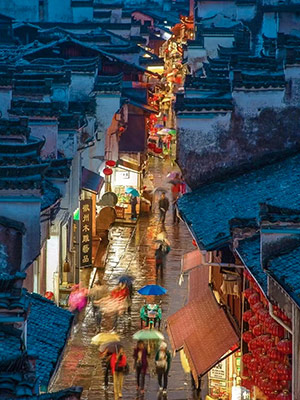



Tunxi Old Street is a well-preserved ancient and prosperous pedestrian commercial street with a total length of 1,272 meters. The entire street comprises more than 300 Huizhou buildings built in different eras. It is a complete ancient street market in China with the architectural styles of Southern Song and Ming and Qing Dynasties. Tunxi Old Street originated from a water port wharf where the three rivers converge. By more than 100 years ago, the area had developed into a relatively complete and prosperous market with banks, pawns, jewelry shops, medicinal materials, silk, Department stores, groceries, salt, sugar, porcelain, cigarettes, tin foil, paper, restaurants, etc. other industries. The old street is narrow, and the pavement is brown-red slab stone; the ancient buildings on both sides are all brick and wood structures, with whitewashed walls and tiles and superb carving skills on the window lintel. The horsehead wall between the houses constitutes the beauty of Huizhou architecture.
. Xidi Ancient Town




The Xidi Ancient Town was built in 1047 AD. Most of the residents here have the last name Hu, who are said to be descendants of the royal family of the Tang Dynasty. At the same time, most of the dwellings here were built by high-ranking officials who lived in the imperial capital for a long time and then returned to their hometowns, so these buildings are exquisite. The courtyards of Hui-style dwellings usually have high walls and small windows. In ancient times, Hui-merchants began to go out for business when they were 13 years old, so only women, older people, and children were left at home. To guard against theft, the male host often builds high walls and small windows in the courtyard and houses.
. Tachuan Village
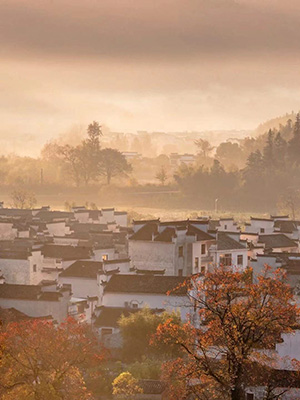



The autumn colors of Tachuan, Jiuzhaigou in Sichuan, Kanas in Xinjiang, and Xiangshan in Beijing are known as the four great autumn colors in China. The red color of Tachuan is dominated by Chinese tallow trees, mixed with sweetgum trees, persimmon trees, chestnut trees, ginkgo trees, mountain pepper trees, and so on, presenting different levels of colors such as green, yellow, gold, and red. The white walls and black tiles are dazzling in the shadows of the trees, forming a unique picture of autumn.
. Chengkan Village
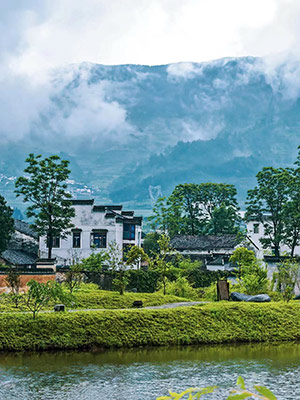
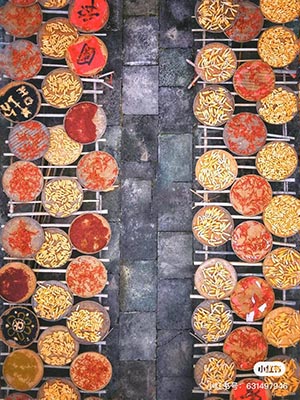


Chengkan Village has a history of more than 1,800 years and is laid out by the gossip geomantic theory of the ancient Chinese wisdom “Book of Changes.” The village is built on the hillside and close to the river, in line with the geomantic principle of “backing mountains, flowing water, and facing mountains.” The S-shaped dragon stream flows through and divides Chengkan Village into Yin and Yang. It plays the role of fire fighting and drainage and facilitates the villagers to irrigate the farmland. Chengkan Village retains a strong custom of drying autumn. The villagers dried colorful corn, rice, pumpkins, and peppers on the terrace or square.

